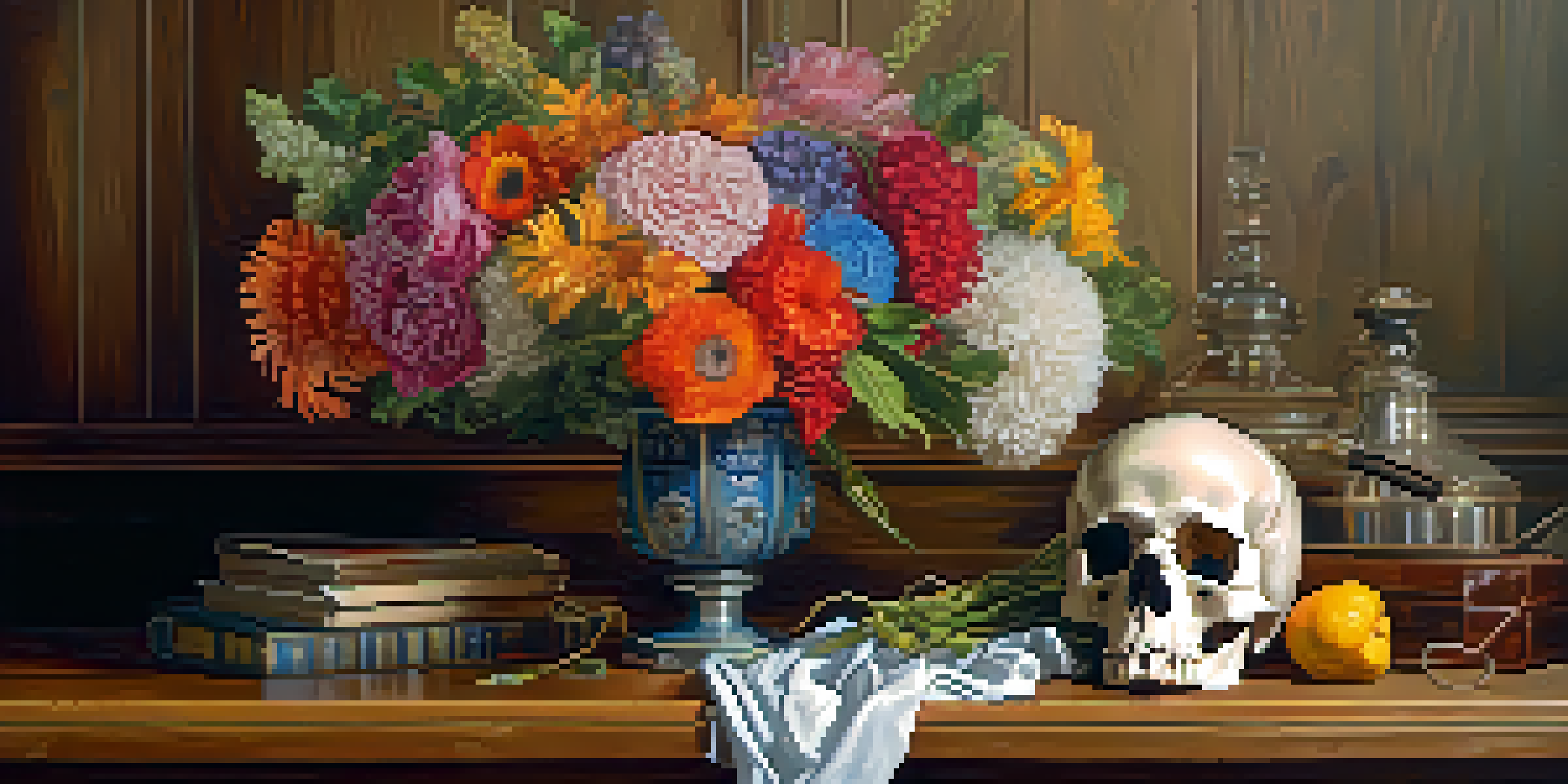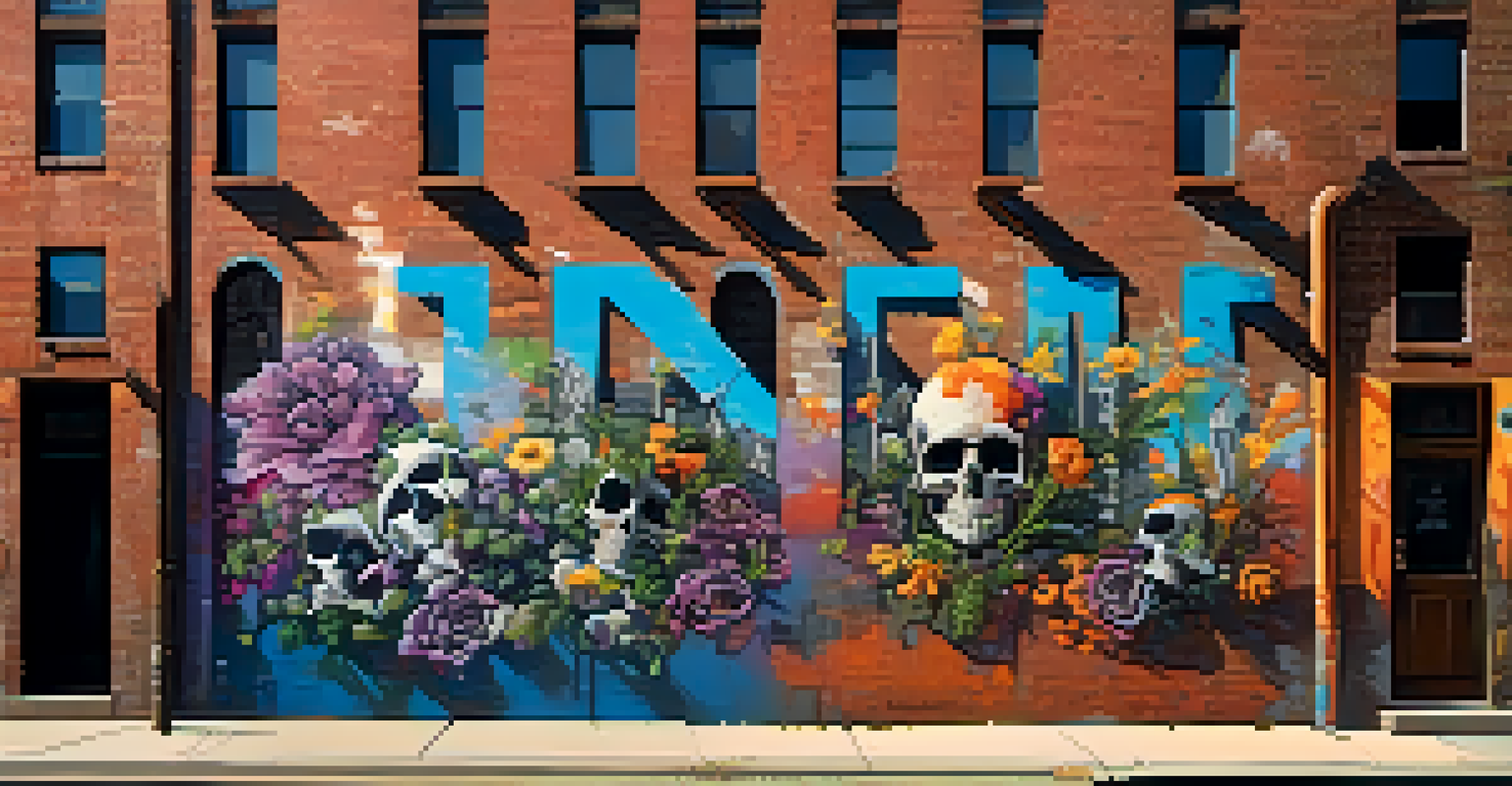The Power of Memento Mori in Art: Remembrance and Reflection

Understanding Memento Mori: A Brief Overview
Memento Mori, a Latin phrase meaning 'remember you must die', serves as a powerful reminder of mortality. It encourages individuals to reflect on the fleeting nature of life and the inevitability of death. Originating in the medieval period, this concept has transcended time, influencing various art forms throughout history.
To be yourself in a world that is constantly trying to make you something else is the greatest accomplishment.
Artists used Memento Mori as a central theme to provoke thought about existence, leading to a deeper appreciation of life. Through symbols like skulls, hourglasses, and decaying flowers, these works invite viewers to confront their own mortality. This reflection can foster a more meaningful and enriched perspective on living.
The impact of Memento Mori extends beyond art; it resonates in philosophy and literature, urging us to cherish our experiences. By understanding this concept, we not only enhance our appreciation for art but also cultivate a deeper connection with our own lives.
Historical Roots of Memento Mori in Art
The roots of Memento Mori can be traced back to the medieval era, particularly within Christian art. Images depicting death served as reminders of the afterlife and the importance of virtue. This practice was not only a reflection of societal beliefs but also a call for introspection among viewers.

During the Renaissance, artists like Hans Holbein the Younger embraced Memento Mori in their works, often featuring skulls and rotting fruit. These elements starkly contrasted with the beauty of life, emphasizing the transient nature of existence. The interplay of life and death became a profound statement about human experience.
Memento Mori: Embrace Mortality
The concept of Memento Mori encourages us to reflect on our mortality, leading to a deeper appreciation for life.
As art evolved, so did the representation of Memento Mori. From Baroque to Romanticism, artists continued to explore mortality, each adding their unique perspective. This evolution highlights the enduring relevance of Memento Mori in the artistic narrative, reminding us that life and death are intertwined.
Symbolism in Memento Mori Artworks
Symbolism plays a crucial role in Memento Mori artworks, where every element conveys deeper meaning. Common symbols include skulls, which represent death, and withering flowers, illustrating the brevity of beauty. These symbols are not just decorative; they serve as poignant reminders of life's impermanence.
Death is nature's way of telling you to slow down.
Artists often use contrasting imagery to heighten the emotional impact of their works. For example, a vibrant still life may be accompanied by a skull, prompting viewers to reflect on the fleeting nature of pleasure. This juxtaposition encourages a dialogue about the value of life and the inevitability of death.
Through these symbols, Memento Mori art creates a space for contemplation. Viewers are invited to pause, reflect, and consider their own lives, making the experience both personal and universal. The ability of these artworks to engage audiences is a testament to their enduring power.
Memento Mori in Contemporary Art
In today's world, Memento Mori continues to inspire contemporary artists who explore mortality in innovative ways. From installations to performance art, the theme remains relevant as society grapples with issues of life and death. Artists like Damien Hirst challenge viewers to confront their mortality through shocking and thought-provoking pieces.
Contemporary Memento Mori often incorporates modern symbols, such as digital screens and urban decay, reflecting our current relationship with death. This evolution shows how the concept adapts to cultural shifts while remaining rooted in its original message. It highlights the ongoing need for reflection in a fast-paced world.
Art's Role in Reflecting Life
Throughout history, Memento Mori has influenced artists to create works that provoke thought about the transient nature of existence.
As artists push boundaries, they invite audiences to engage with mortality in ways that resonate personally. This engagement fosters a deeper understanding of life’s fragility, encouraging viewers to appreciate the present moment. Memento Mori in contemporary art serves as a bridge between past and present, reminding us to live fully.
Psychological Impact of Memento Mori in Art
The psychological impact of engaging with Memento Mori artworks can be profound. Confronting themes of death often leads to heightened awareness of our own mortality, which can be unsettling but ultimately liberating. This confrontation encourages individuals to reflect on their values and priorities.
Research suggests that contemplating death can enhance our appreciation for life. By facing the reality of mortality, we may find ourselves more motivated to pursue our passions and strengthen relationships. Memento Mori art serves as a catalyst for these reflections, prompting transformative experiences.
Moreover, the shared experience of viewing Memento Mori art fosters connections among individuals. Discussions about mortality can bridge generational gaps and create a sense of community. In this way, the psychological effects of these artworks extend beyond personal reflection, contributing to broader societal conversations.
Embracing Memento Mori: Lessons for Modern Life
Embracing the lessons of Memento Mori can lead to a more meaningful life. By acknowledging our mortality, we can prioritize what truly matters, fostering deeper connections with loved ones. This mindset encourages us to live authentically, pursuing our passions without the fear of judgment.
Incorporating Memento Mori into daily life can take many forms, such as setting intentions or practicing mindfulness. These practices help us stay grounded and aware of our surroundings, allowing us to savor each moment. This intentional living cultivates gratitude and appreciation for life’s fleeting beauty.
Lessons for Living Authentically
By embracing Memento Mori, we can prioritize meaningful connections and live authentically, fully appreciating the present moment.
Ultimately, Memento Mori invites us to reflect on our legacies. What do we want to be remembered for? This reflection can motivate us to contribute positively to our communities, ensuring that our impact endures long after we are gone. Embracing this philosophy enriches our lives and those of others.
Conclusion: The Enduring Power of Memento Mori
In conclusion, Memento Mori remains a powerful theme in art, offering timeless lessons about life and death. Its ability to provoke thought and encourage reflection continues to resonate with audiences today. Through its rich symbolism and historical significance, Memento Mori art serves as a reminder of our shared human experience.
As we navigate the complexities of modern life, engaging with Memento Mori can provide clarity and perspective. It urges us not only to reflect on our mortality but also to celebrate the beauty of existence. This duality enriches our understanding of life, making the philosophy incredibly relevant.

Ultimately, the power of Memento Mori lies in its ability to inspire. By inviting us to confront our mortality, it encourages us to live with intention and purpose. As we appreciate the art that embodies these themes, we also cultivate a deeper connection to our own lives and the world around us.